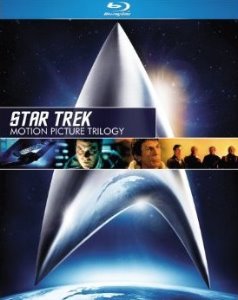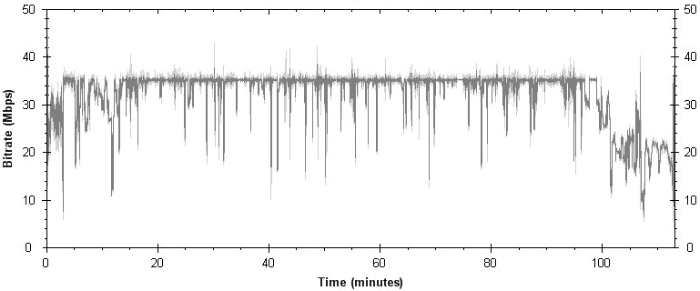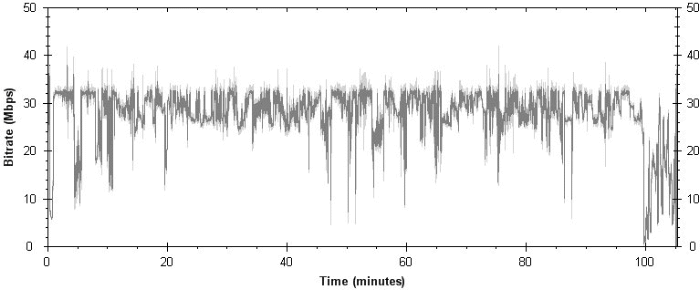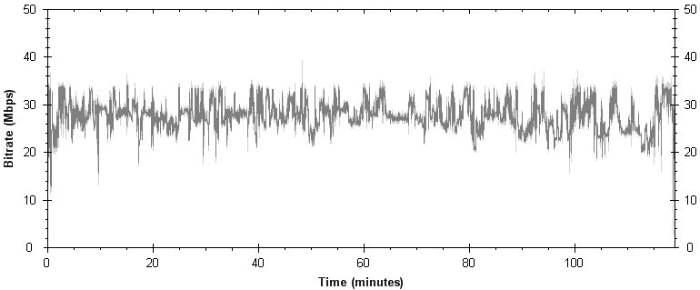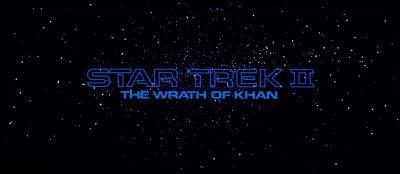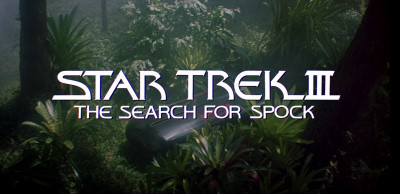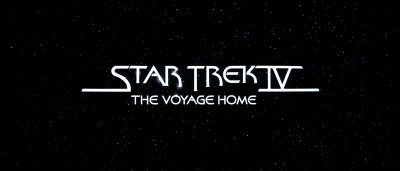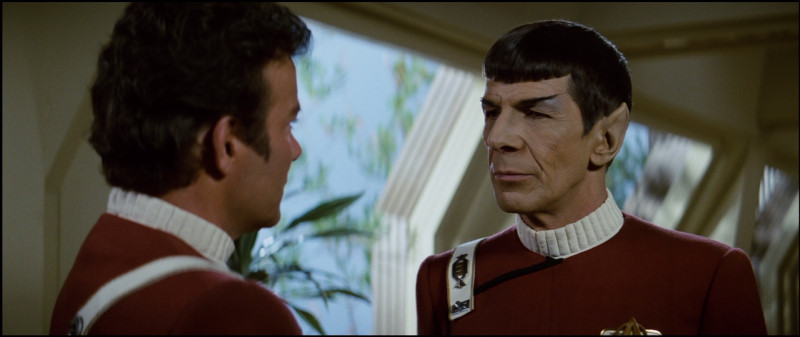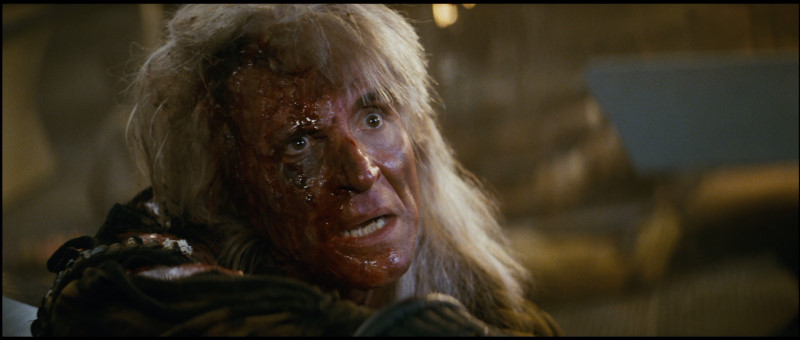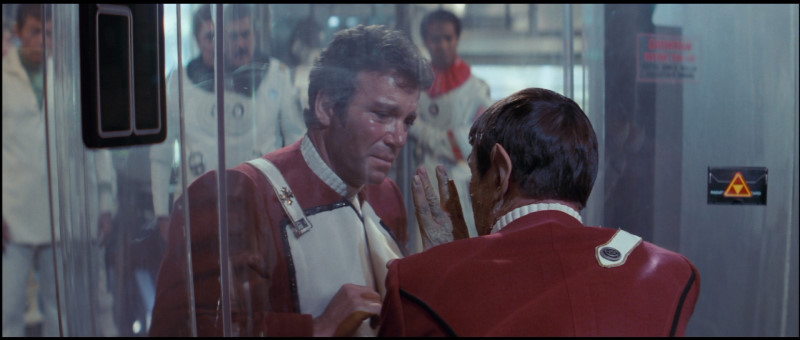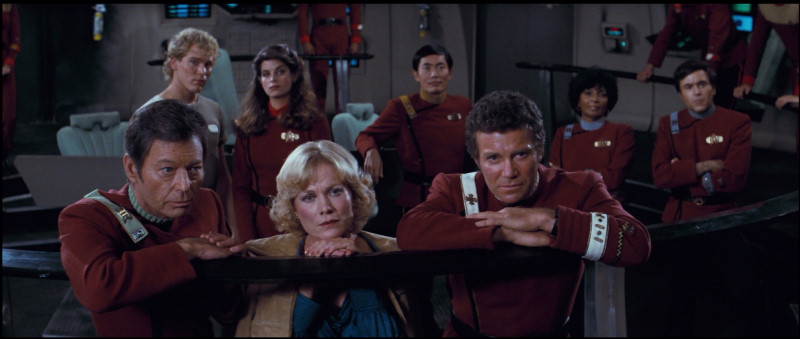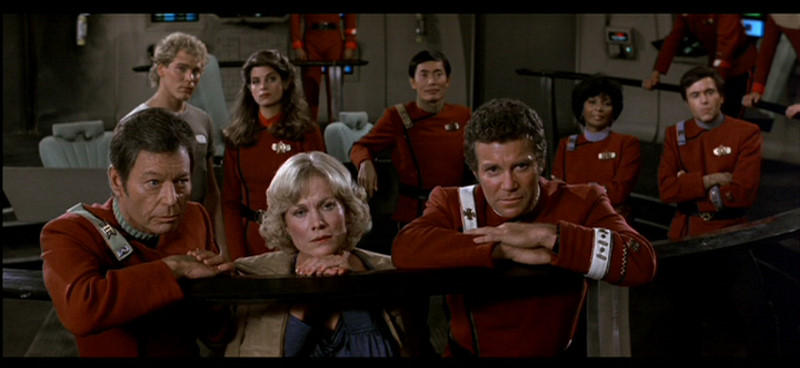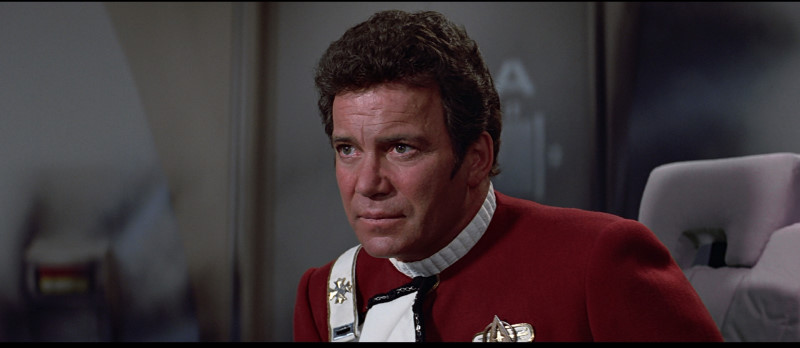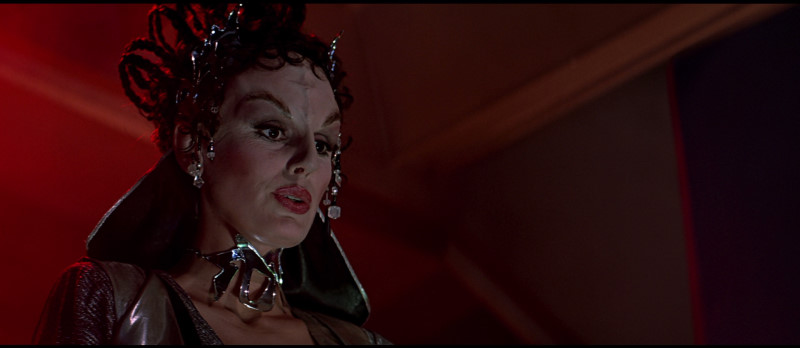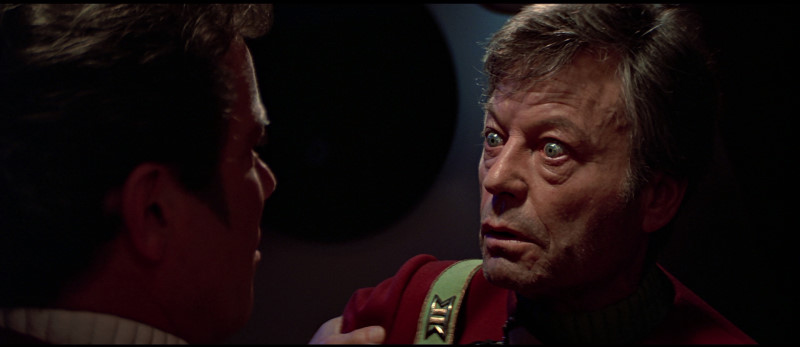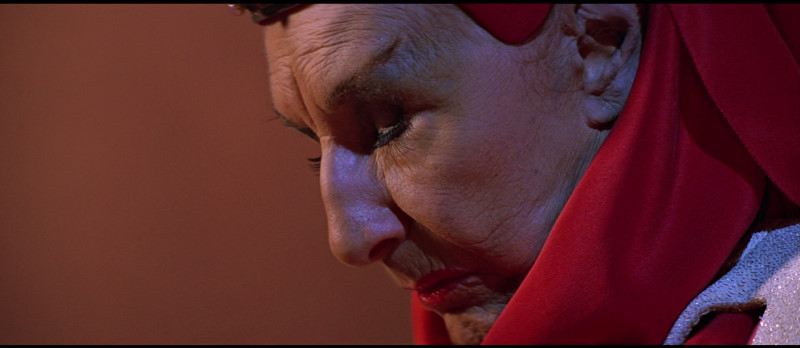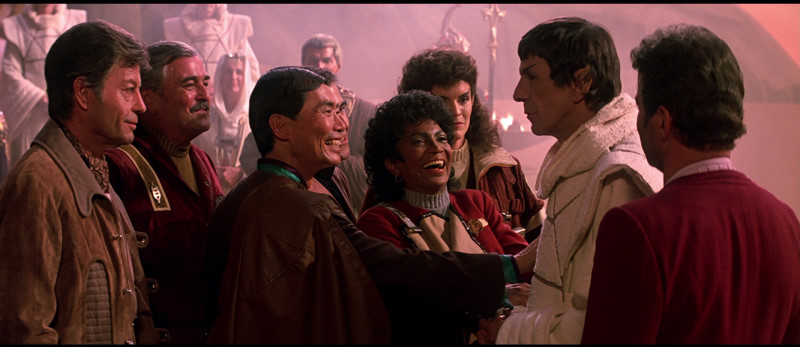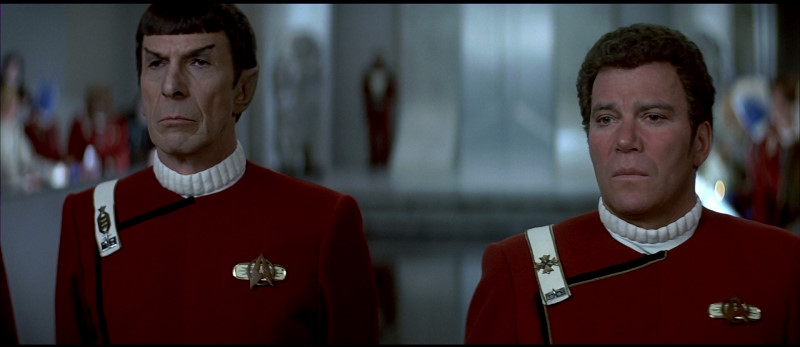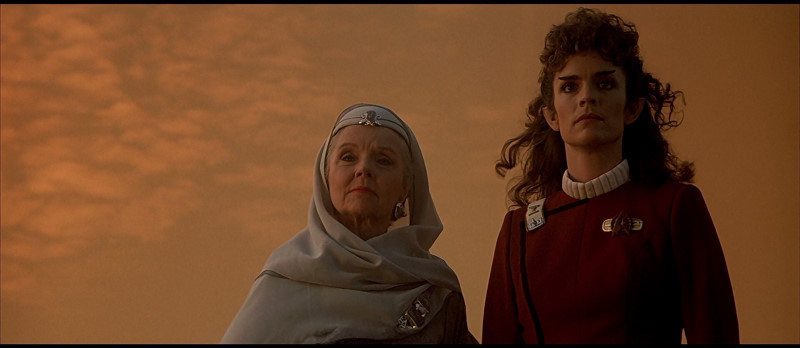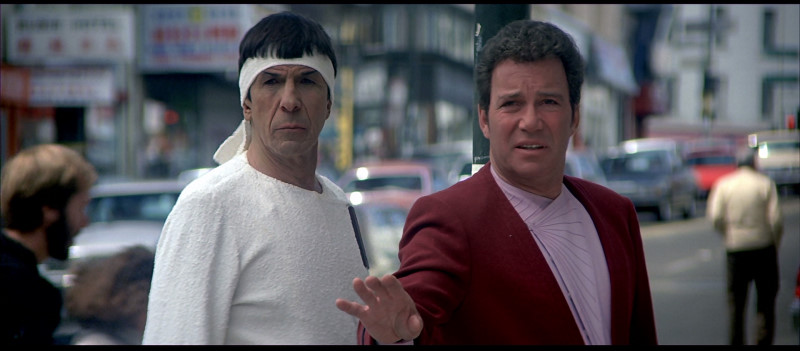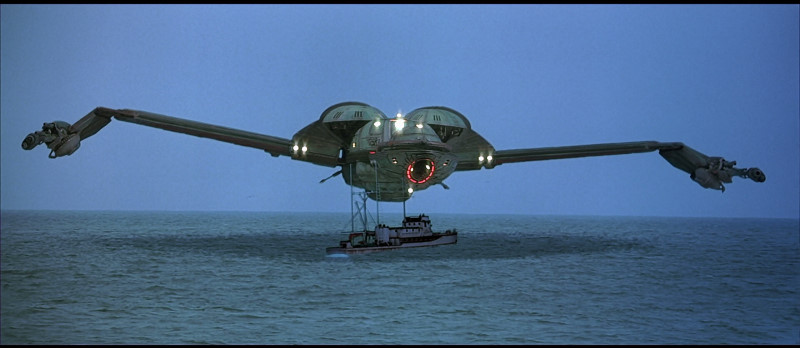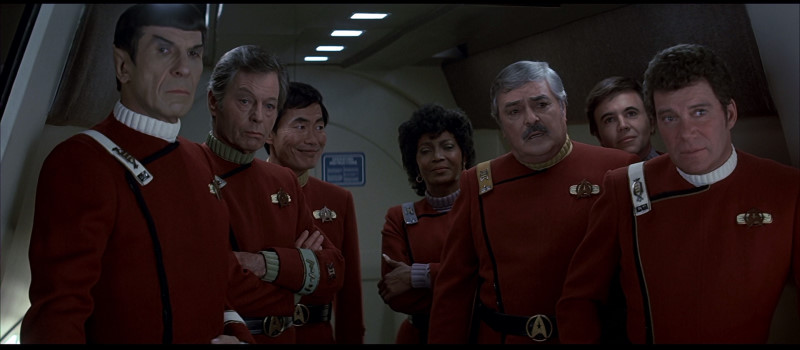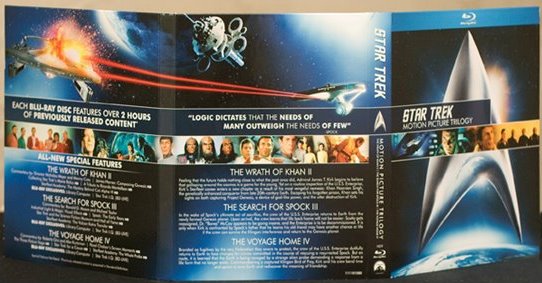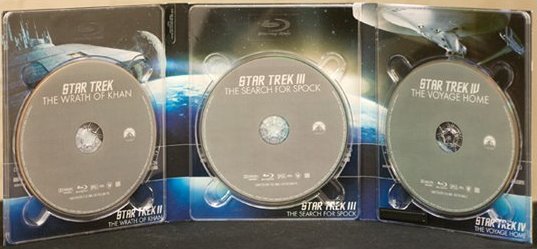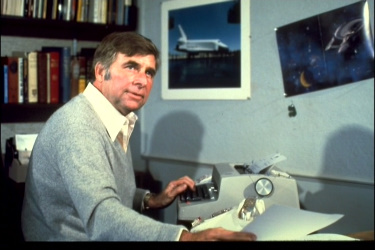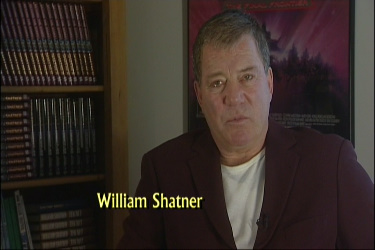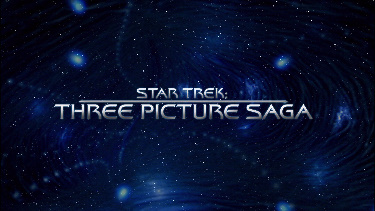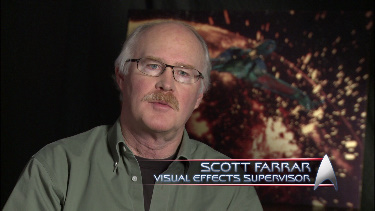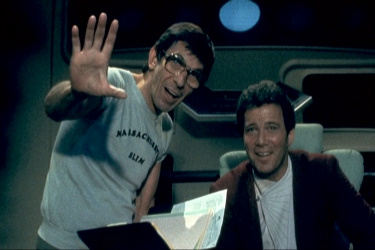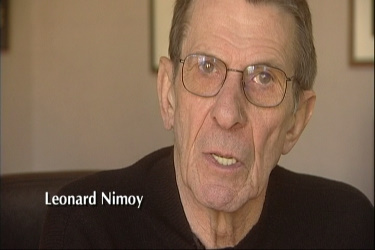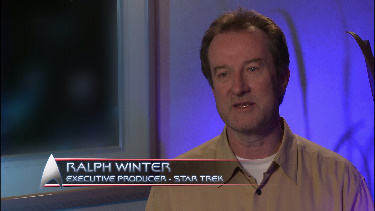![]()
![]()

![]()
![]()
L e n s V i e w sA view on Blu-ray and DVD video by Leonard Norwitz |
|
The Star Trek Motion Picture Trilogy [Blu-ray] (The Wrath of Khan | The Search For Spock | The Voyage Home)
(Nicholas Meyer, 1982, - Leonard Nimoy, 1984, 1986)
Review by Leonard Norwitz
Studio: Theatrical: Paramount Studios Blu-ray: Paramount Home Entertainment
Disc: Region: FREE (as verified by the Momitsu region FREE Blu-ray player)
Case: 3-tiered digipak (see image below)
Bitrates:
Video: Aspect ratio: 2.35:1 Resolution: 1080p Video codec: MPEG-4 AVC Video
Audio:
Dolby TrueHD Audio English 4509 kbps 7.1 / 48 kHz / 4509
kbps / 24-bit (AC3 Core: 5.1-EX / 48 kHz / 640 kbps)
Subtitles: English SDH, English, French, Portuguese, Spanish, none
Extras: • See Below
Introductory Comment: Timed to coincide with the release of the new Star Trek movie, Paramount is offering a host of original cast Star Trek material on Blu-ray. Already in print, available April 28th, 2009, is the Complete First Season of the original TV series and on the 12th of May - two box sets: one containing all six theatrical movies from 1979-91 (The Motion Picture Collection) and another, cleverly packaged as a trilogy: the story of Spock's death, resurrection, and return. This latter grouping, of course, are Star Treks II-III-IV: The Wrath of Khan, The Search for Spock and The Voyage Home.
It's hard to imagine from our vantage point, what with the resounding success of The Next Generation and Voyager and to a lesser, but still influential effect, the Deep Space Nine and Enterprise series and the several TNG feature films, but there once was a time when the Star Trek franchise was pretty much dead and buried as far as its production studio and distributor, Paramount, was concerned. The TV series almost didn't make it to a third season and the studio's interest waned before it was over, as evidenced by a lowering of production values. A dozen or so years later, the first feature film came out, spurred on by humongous fan interest and gobs of hype. Now production values could be seen in every frame but, alas, not in the script. And once again, the series looked it was it about to get flushed.
Somehow, with a new director, Nicholas Meyer, and a new producer, Harve Bennett - especially Bennett, who would take the franchise all the way through the unhappy Star Trek V – the series resuscitated itself enough to find interested in what was to become The Next Generation, commanded by the redoubtable Jean Luc Picard, aka Patrick Stewart. Bennett and Nimoy saw the potential of the idea of a trilogy even before Spock was regenerated by Genesis, though there was no such idea, Nimoy assures us in his impassioned and candid commentary for The Search for Spock (his first voyage as a feature film director, by the way), when The Wrath of Khan was in production.
Amid such turmoil it was no surprise that once Spock was killed off at the end of Star Trek II, it seemed to be accepted fact that this was only the beginning of the end. And once again, with Star Trek III, the lack of sufficient money was visible for all to see on the screen. It is no wonder that Star Trek IV was shot largely on location in and around San Francisco. My feeling is that both Star Trek III and Star Trek IV could have been much better if it weren't for their rather shabby production values – most of what happens on the Genesis Planet and the hunt for the whales in arctic waters suck big time.
Just as with the TV series, we all have favorites and our favorite duds. In any case, Kirk and company can always be counted on for a couple of hours of predictable entertainment. The Trilogy, as we shall now refer to it, contains what is arguably the best of the original cast movies: The Wrath of Khan. The other two suffer in comparison, especially, I think, The Search for Spock - though it does have some of the most interesting art work of all the movies - with The Voyage Home coming off more as an expanded TV movie episode, grounded as it were mostly in present day Earth. Even so, the three movies make for a good story arc, if not a satisfying dramatic flourish.
The Wrath of KhanAs we all must know by now The Wrath of Khan is the epilogue to the TV episode from the first season titled Space Seed. One of the best of those adventures, it starred Ricardo Montalban as Khan, the leader of a band of genetically enhanced supermenchen – "criminals" would be more apt - who escape Earth's near future in a space ship designed to keep its passengers in sleep mode until they reach their destination a few hundred years into the future. As it happens, the Enterprise comes across them and wakes them up prematurely. Proving once again the adage "No good deed goes unpunished" Kirk welcomes these travelers as guests, but Khan repays hospitality with an attempted mutiny, which nearly comes off. Kirk abandons Khan and his group, along with one of his crew, Lt. Marla McGivers, who becomes Khan's wife on Ceti Alpha V, where Kirk imagines Khan will find a way to lord it over whatever he may find there.
The movie opens some 15 years later as the USS Reliant, commanded by Clark Terrell (Paul Winfield) with Chekov in tow visits what they believe is Ceti Alpha VI, a possible candidate for regeneration by the Genesis Device, but is really Ceti Alpha V, that planet's having shifted its orbit some while earlier when Ceti Alpha VI went kablooey, leaving V out of orbit and something of a wasteland. Oops! So who should Chekov and Terrell meet but what is left of Khan and his crew, who take advantage of the advantage he always has of surprise, ferocity, smarts and obsessive determination. (Chehov, by the way, was not in Space Seed, despite Khan's recognition of him here.) This time around Khan succeeds in his takeover of a starship, but instead of striking out to find a more hospitable world to settle on, he first decides to learn more about Genesis.
The Genesis Project, a sort of rapid-growth terraformer – if it should work - is led by Admiral Kirk's Starfleet Academy girlfriend of twenty-odd years ago: Dr. Carol Marcus, and her son, David. Any guesses who he might be? When the Enterprise arrives, following up on a distorted message from Marcus, Kirk finds nearly everyone of the scientists murdered, and his old friend Khan just waiting for an opportunity to wreak his vengeance on the man he holds responsible for the death of his wife and most of his original crew.
The Movie : 9
Image : 9/9 NOTE: The below Blu-ray captures were ripped directly from the Blu-ray disc. The first number indicates a relative level of excellence compared to other Blu-ray video discs on a ten-point scale. The second number places this image along the full range of DVD and Blu-ray discs.
I had forgotten just how good the 2-disc DVD looked until I popped it in for comparison to the Blu-ray. The blacks are crushed, yes, and there is a certain amount of edge enhancement, but colors are vivid and it's remarkably sharp. But the Blu-ray is something else again. Putting aside for the moment, the difference in color – the Blu-ray is decidedly redder and bluer, as is often the case in this medium – there is that familiar degree of dimensionality that is occasionally jaw-dropping, even when subtle. A good example can be seen early on at the tail end of the discussion between Kirk and Spock about the Kobayashi Maru training exercise. They arrive at an elevator, to the left of which is a giant transparent globe. On the DVD the globe could be mistaken for a disc, on the Blu-ray it is clearly a sphere. There is also considerably more shadow information on the Blu-ray, as when Kirk's shuttle is heading out to dock with the Enterprise. Nor is it a case of simply brightening the image, which I don't see as going on anyway. We can find a wee bit of edge enhancement but only if you're looking for it instead of enjoying the movie – which is hard not to do. There's a good deal of black in space, less so around the docking areas. I was surprised at this, but it made a certain sense. I noticed no noise for all the opportunity that presents.
Blu-ray TOP vs. Special Collectors Edition DVD - BOTTOM
Blu-ray TOP vs. Special Collectors Edition DVD - BOTTOM
Audio & Music : 9/8 As much of an improvement as there is over the DVD in terms of image, I was simply bowled over by the audio. I can't remember if I've ever encountered such theatrically shaped vocal reproduction on any video. Voices are big, as we hear them in the theater, but also focused and higher up the film plane instead of in the center. How did they do that, I wondered? I don't mind if this remains a mystery, but I would not hesitate to recommend the set purely for the experience. (Curiously, nothing like this effect is the case in the succeeding movies.) Jerry Goldsmith had been the composer for the first Star Trek movie, but the producers decided on up-and-coming James Horner, who was too young to be accused of the sort of derivative plagiarism that often beset his work. In any case, his score here nails the duel between Kirk and Khan perfectly and the percussive elements are dynamically realized in the uncompressed audio mix. Surround elements come into play for effects – subtle and dynamic, as well as the music. Of particular note is how the sense of space opens up even on the bridge of a starship. While we might expect that the bridge might actually be devoid of mechanical and deep rumbling noises, their insertion here makes for a more visceral presentation.
Extras : 9 • Audio commentary by Director Nicholas Meyer • Text commentary by Michael Okuda • Library Computer • Captain's Log – in SD (27:21) • Designing Khan – in SD (23:54) • Visual Effects – in SD (18:14) • Original Interviews – in SD (10:56) • The Star Trek Universe: A Novel Approach – in SD (28:55) • The Star Trek Universe: Collecting Star Trek Movie Relics – in HD (11:05)* • The Star Trek Universe: Starfleet Brief on Ceti Alpha VI – in HD (3:02)* • 13 Storyboard Archives • Tribute to Ricardo Montalban by Director Nicholas Meyer (4:44)* • Trailer in SD
As is the case with the other two movies in the Trilogy, it appears that all of the Special Features from the 2-disc Collector's Edition DVDs are imported to the Blu-ray. What's new for all three movies is the interactive "Library Computer." When activated, a translucent overlay appears on one side of the screen that permits clicking on various aspects of related culture, science & medicine, Starfleet operations, life forms, characters, and space ships. Navigation is intuitive, and the selections from the computer evolve as the movie progresses. Very cool.
The Star Trek Universe has been expanded to include an eleven-minute segment on the collecting, auctioning and archiving Star Trek memorabilia and a clever little presentation by a representative from Starfleet as to exactly what happened to Ceti Alpha VI. Both of these are presented in HD. There is also a memorial tribute to Ricardo Montalban offered by Director Nicholas Meyer.
I won't touch on the duplicated features except to note that perhaps even more than the commentaries for the two other films in the Trilogy, Meyer's frankness about the trials and tribulations of production and behind-the-scenes machinations is both fascinating and refreshing.
By the way, I was only able to access most of the Extra Features from the home page menu. Beware – and also always make sure you have the latest firmware update.
The Search for Spock Kirk, his crew and all of Starfleet mourns the loss of Spock who had sacrificed himself to save his ship and all aboard at the end of Star Trek II. McCoy, however, seems to be uniquely affected. He walks about like a ghost, or more like he's possessed by one – which he is. Sarek (Mark Lenard, in perhaps the best scene in the movie) confronts Kirk about why he did not bring his son's remains back to Vulcan, insisting that Spock would have made this wish clear as he saw the inevitable coming. Ah - McCoy! The problem is that Genesis has since become a forbidden subject by order of Starfleet, and Kirk's plea that he be permitted to return to the Genesis Planet to bring Spock home is perfunctorily denied. Do we think this stops Kirk – not for a parsec (sic! – in honor of Han Solo's misappropriation of time for distance.)
To complicate matters, Klingon Commander Kruge's Bird of Prey comes into possession of intelligence regarding Genesis. Upon arriving at the planet he finds David Marcus and Lt. Saavik (now impersonated by Robin Curtis) who are looking for an unexplained life form on the Genesis Planet. Hmmm. Could this rapidly aging boy they find with the funny ears be Spock – or could he become so, providing the planet, which turns out to be completely unstable (way to go, David), consumes all of them. Needless to say that Kirk and Kruge will have to explore their differences as to the fate of Genesis.
The Movie : 6
Image : 8/9 The first number indicates a relative level of excellence compared to other Blu-ray video discs on a ten-point scale. The second number places this image along the full range of DVD and Blu-ray discs.
I could save a lot of space by simply saying "ditto" my remarks about Star Trek II, but alas, things aren't quite that simple. Clearly, this transfer is not made from the same master as was the DVD. Like the other two movies in the Trilogy, it has been seriously reconsidered. Even so, there is less information in the shadows than in the previous movie – which is not to say that there is supposed to be more or that the transfer glosses over them. The scenes on the Genesis Planet aside – I think it's best for all concerned that we speak in hushed tones about those – the image always looks less far two-dimensional than the DVD. Resolution and sharpness is very good and lacks that grainy pixilation we see on the DVD. If there is edge enhancement, I did not find it noticeable, and the scenes where it leapt off the screen on the DVD did not show up on the Blu-ray at all.
Color saturation is a marvel – like the comic book. The scenes involving the Klingon ship and in and around Vulcan's temples are like freshly painted 3-dimensional art pieces. Speaking of dimension, take a look at Gary's screen caps of Kirk in The Search for Spock: The longer you stare at these two frames the flatter the DVD looks. It's not that the Blu-ray looks natural – it is, after all, the result of careful lighting to produce a desired effect, but that effect could not possibly have been what we see on the DVD. On the other hand, the more highly resolved the image, the hokier the makeup and some of the costumes (Where did the Vulcans come up with those chin straps?)
The Search For Spock
Blu-ray TOP vs. Special Collectors Edition DVD - BOTTOM
Blu-ray TOP vs. Special Collectors Edition DVD - BOTTOM
Audio & Music : 7/8 Again, compared to the DVD, the Blu-ray high-def audio mix scores, but not nearly as large or as dynamic as with Wrath of Khan. By comparison it's all just a little anemic.
Extras: 9 • Audio commentary with Director Leonard Nimoy, Producer Harve Bennett, DP Charles Correll and Actor Robin Curtis • Audio commentary by Ronald D. Moore and Michael Taylor • Library Computer • Captain's Log – in SD (26:13) • Terraforming and the Prime Directive – in SD (25:53) • The Star Trek Universe: Space Docks and Birds of Prey – in SD (27:49) • The Star Trek Universe: Speaking Kingon – in SD (21:04) • The Star Trek Universe: Klingon and Vulcan Costumes – in SD (12:16) • The Star Trek Universe: Star Trek & the Science Fiction Museum & Hall of Fame – in HD (12:16)* • The Star Trek Universe: Starfleet Brief on the Vulcan Katra Transfer – in HD (2:42)* • Storyboards • Photo Gallery • Trailer in SD
As is the case with the other two movies in the Trilogy, it looks like all of the Special Features from the 2-disc Collector's Edition DVDs are imported to the Blu-ray. What's new for all three movies is the interactive "Library Computer." When activated, a translucent overlay appears on one side of the screen that permits clicking on various aspects of related culture, science & medicine, Starfleet operations, life forms, characters, and space ships. Navigation is intuitive, and the selections from the computer evolve as the movie progresses. Very cool.
In place of the Ichuda text commentary is a new audio commentary with Ronald D. Moore and Michael Taylor (former Star Trek series producer and staffer) – a perfectly acceptable and entertaining perspective by people who had nothing to do with this movie, but were involved with the TV series franchise since. The new interactive "Library Computer" is still with us: When activated, a translucent overlay appears on one side of the screen that permits clicking on various aspects of related culture, science & medicine, Starfleet operations, life forms, characters, and space ships. Navigation is intuitive, and the selections from the computer evolve as the movie progresses.
There are also a couple of items in HD (all the DVD features are in SD, as expected) in the Starfleet Universe, the more interesting being the featurette about the Science Fiction Museum in Seattle.
By the way, I was only able to access most of the Extra Features from the home page menu. Beware – and also always make sure you have the latest firmware update.
The Voyage Home Now safely back on Vulcan, Spock seems to have regained his form and most of his marbles, and now the crew must make their way back to Earth in an appropriated Bird of Prey. Thanks to Kirk, they are now outlaws for having visited Genesis and appropriated a starship to do so (and lost it in the bargain), but no matter, Earth is facing a serious challenge of its own. A probe from a distant star system has taken up orbit around the planet and seems hell bent on Earth's destruction. When their newly christened Klingon vessel, Botany Bay (a great touch, don't you think) arrives on the scene Spock determines that there can be no response to the probe because its communication is intended for a species now extinct (way to go, Earth people). Spock suggests that if they could manage a solar slingshot they might be able to arrive in the past when humpback whales - for it is they for whom the probe tolls - still existed.
The search for whales that Kirk can transport up to the ship – a stretch, I realize, but it works better on the screen than on the page – leads him and Spock to the Monterey Aquarium, standing in for the "Cetacian Institute." Meanwhile Chekov and Uhura are sent off to locate a power source to activate their depleted dilithium crystals and Scotty and McCoy search for a substitute for transparent aluminum, which, as we all know, hasn't been invented yet. After a hiatus of one full-length movie, wherein Kirk was distracted from romantic entanglements by more important matters, he once again finds himself the subject and object of a loose woman, so loose - in fact, she doesn't mind being shipped off to the future.
I have to confess two things about my reaction to this movie: the first is that there is an in-my-face political correctness about its basic ecological theme that I find tiresome on rewatch, and I always have. It's a proper message – and all the more so for its being timely - but it is far from subtly dramatized. On the other hand, and perversely, I thoroughly enjoy the crew's humorous and anachronistic adventure in our time zone – or what was our time zone 20-odd years ago, which makes for an even more textured play on the clash of cultures, looking at it from here.
The Score Card
The Movie : 7
Image : 7/8 The first number indicates a relative level of excellence compared to other Blu-ray video discs on a ten-point scale. The second number places this image along the full range of DVD and Blu-ray discs.
By some measure, The Voyage Home offers the least dynamic image overall of the Trilogy. There are inconsistencies to the contrast that gives one pause. Some appear arbitrary, some are errors. Check out the Bird of Prey as it sits on its dock on Vulcan at 07:12 and 13:40 minutes: Presumably, the reason the shadowing under the ship is so strong at 13:40 is that it is now later in the day, but the shadows on the rocks behind the ship indicate that the sun is still in the same position. Looks like there wasn't enough money to repaint the matte. No matter, the Blu-ray positively wipes the floor with the previous DVD, which was thin and grainy to such a point that if there was enhancement we wouldn't be able to see it. Even the scenes on location in San Francisco now have life to them. Whew!
The Voyage Home
Audio & Music : 6/8 I can't say that there's much to the audio mix here, but that seems to be largely by design. The story is basically a romantic comedy and is largely front-directed. The probe sounds are cool and have a rich electronic texture that is quite tingly and tangible, and the storm the Botany Bay encounters on its return have some drama, but there's little else that captures out attention.
Extras: 8 • Audio commentary with Director Leonard Nimoy and Actor William Shatner • Audio commentary by Roberto Orci and Alex Kurtzman • Library Computer • Production: Future's Past – in SD (27:32) • Production: On Location – in SD (7:26) • Production: Dailies Deconstruction – in SD (4:13) • Production: Sound Design – in SD (4:45) • Production: Pavel Chekov's Screen Moments – in HD (6:09)* • Visual Effects in SD (17:35) • Original Interviews – in SD (43:15) • The Star Trek Universe: Time Travel – in SD (11:15) • The Star Trek Universe: The Language of Whales – in SD (5:46) • The Star Trek Universe: A Vulcan Primer – in SD (7:50) • The Star Trek Universe: Kirk's Women – in SD (8:19) • The Star Trek Universe: The Three Picture Saga – in HD (10:12)* • The Star Trek Universe: Star Trek for a Cause – in HD (5:40)* • The Star Trek Universe: Starfleet Brief re The Whale Probe – in HD (3:42)* • Tribute: Gene Roddenberry (8:17) • Tribute: Mark Lenard (12:44) • Storyboards • Photo Scrapbook (3:55) • Trailer in SD
As is the case with the other two movies in the Trilogy, it appears that all of the Special Features from the 2-disc Collector's Edition DVDs are imported to the Blu-ray. New for all three movies is the interactive "Library Computer." When activated, a translucent overlay appears on one side of the screen that permits clicking on various aspects of related culture, science & medicine, Starfleet operations, life forms, characters, and space ships. Navigation is intuitive, and the selections from the computer evolve as the movie progresses.
I can't say that the Shatner/Nimoy commentary is especially informative – more like reminiscence, though Nimoy is the more interesting when he does speak. In place of the Ichuda text commentary is a new audio commentary with Roberto Orci and Alex Kurtzman, co-writers for the new Star Trek movie. They come close to sharing a birthday and were kids when this movie came out. Theirs is an interesting perspective regarding Star Trek in general and The Voyage Home in particular. The new interactive "Library Computer" is still with us: When activated, a translucent overlay appears on one side of the screen that permits clicking on various aspects of related culture, science & medicine, Starfleet operations, life forms, characters, and space ships. Navigation is intuitive, and the selections from the computer evolve as the movie progresses.
There are also a several items in HD (all the DVD features are in SD, as expected) in the Starfleet Universe, a ten-minute discussion about the Trilogy concept is probably the most worthwhile unless you've heard enough about it elsewhere by the time you get here. Walter Koenig is amusing, as always (I met him a while back at a Convention in L.A.) as he talks about his moment in the sun, or at least being chased by the U.S. Navy.
By the way, I was only able to access most of the Extra Features from the home page menu. Beware – and also always make sure you have the latest firmware update.
Packaging:
Sample Supplements:
Recommendation: 10 With the exception of Star Trek VI: The Undiscovered Country, the Trilogy, as we can now call it, comprises the best of the original cast movies. The story arc has a redemptive resonance about it at a number of levels, even if the tone of each movie is very different.
Paramount's Blu-ray set scores in every way except perhaps the box, which isn't bad so much as it is uninspired, and that the previous DVD bonus features remain in standard definition – but that's usually the case anyhow. It's nice that there are two commentaries by people in the Star Trek system but not involved with the movie itself. Make no mistake: the Blu-ray image quality in each case is a significant upgrade from the DVD , and the audio is very much superior on Star Trek II, though more subtly so for the others. Highly Recommended. Leonard Norwitz |
|||||||||||||||||||||||||||||||||||||||||||||||||||||||||||
|
About the Reviewer: I first noticed that some movies were actually "films" back around
1960 when I saw Seven Samurai (in the then popular truncated version),
La Strada and
The Third Man for the first time. American classics were a later and
happy discovery.
BLU-RAY STORE ALL OUR NEW FORMAT DVD REVIEWS
|
![]()
![]()
![]()
![]()
